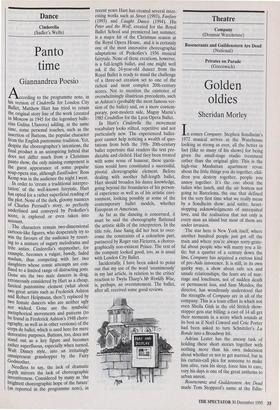Dance
Cinderella (Sadler's Wells)
Panto time
Giannandrea Poesio
cording to the programme note, in his version of Cinderella for London City Ballet, Matthew Hart has tried to retain the original story line of the work (created in Moscow in 1945 for the legendary balle- rina Galina Ulanova) adding, at the same time, some personal touches, such as the Insertion of Buttons, the popular character from the English pantomime tradition. Yet, despite the choreographer's intentions, the final product is an uninspiring hybrid that does not differ much from a Christmas panto show; the only missing component is the guest appearance of some popular soap-opera star, although EastEnders' Ross Kemp was in the audience the night I went.
In order to 'create a traditional interpre- tation' of the well-known fairytale, Hart has opted for a rather superficial reading of the plot. None of the dark, gloomy nuances of Charles Perrault's story, so perfectly underlined and conveyed by Prokofiev's score, is explored or even taken into account.
The characters remain two-dimensional cartoon-like figures, who desperately try to Wirt the favours of the audience by resort- ing to a mixture of sugary melodrama and trite antics. Cinderella's stepmother, for example, becomes a vulgar, bawdy, faded madam, thus competing with her two daughters whose comic attempts are con- fined to a limited range of distracting jests. Gone are the two male dancers in drag, erroneously considered by Hart as a cheap, farcical pantomime element (what about Iwo great artists such as Frederick Ashton and Robert Helpmann, then?) replaced by two female dancers who are neither ugly nor wicked. Gone are the symbolic/ metaphorical movements and patterns (to be found in Frederick Ashton's 1948 chore- ography, as well as in other versions) of the corps de ballet, which is used here for mere decorative purposes. Buttons, too, does not stand out as a key figure and becomes rather superfluous, especially when turned, Walt Disney style, into an irritatingly omnipresent grasshopper by the Fairy Godmother.
Needless to say, the lack of dramatic depth mirrors the lack of choreographic inventiveness. Considered by many as 'the brightest choreographic hope of the future' (as reported in the programme note), in recent years Hart has created several inter- esting works such as Street (1993), Fanfare (1993) and Caught Dance (1994). His Peter and the Wolf, created for the Royal Ballet School and premiered last summer, is a major hit of the Christmas season at the Royal Opera House, and it is certainly one of the most innovative choreographic adaptations of Prokofiev's 1936 musical fairytale. None of these creations, however, is a full-length ballet, and one might well ask if the 24-year-old dancer from the Royal Ballet is ready to stand the challenge of a three-act creation set to one of the richest and most complex 20th-century scores. Not to mention the existence of overwhelmingly illustrious precedents, such as Ashton's (probably the most famous ver- sion of the ballet) and, on a more contem- porary, post-modern side, Maguy Marin's 1985 Cendrillon for the Lyon Opera Ballet.
In Hart's Cinderella the movement vocabulary looks stilted, repetitive and not particularly new. The experienced ballet- goer cannot help noticing a wealth of quo- tations from both the 19th- 20th-century ballet repertoire that renders the text pre- dictable and cliched. Had they been treated with some sense of humour, these quota- tions would have constituted a successful, pivotal choreographic element. Before dealing with another full-length ballet, Hart should broaden his dance knowledge, going beyond the boundaries of his person- al experience as well as of his artistic envi- ronment, looking possibly at some of the contemporary ballet models, whether European or American.
As far as the dancing is concerned, it must be said the choreography flattened the artistic skills of the interpreters. In the title role, Jane Sanig did her best to over- come the constraints of a colourless part, partnered by Roger van Fleteren, a choreo- graphically non-existent Prince. The rest of the company looked good, too, as is usual with London City Ballet.
Incidentally, I have been asked to point out that my use of the word 'unanimously' in my last article, in relation to the critics' reaction to Twyla Tharp's Mr Worldly llise, is, perhaps, an overstatement. The ballet, after all, received some good reviews.


















































 Previous page
Previous page